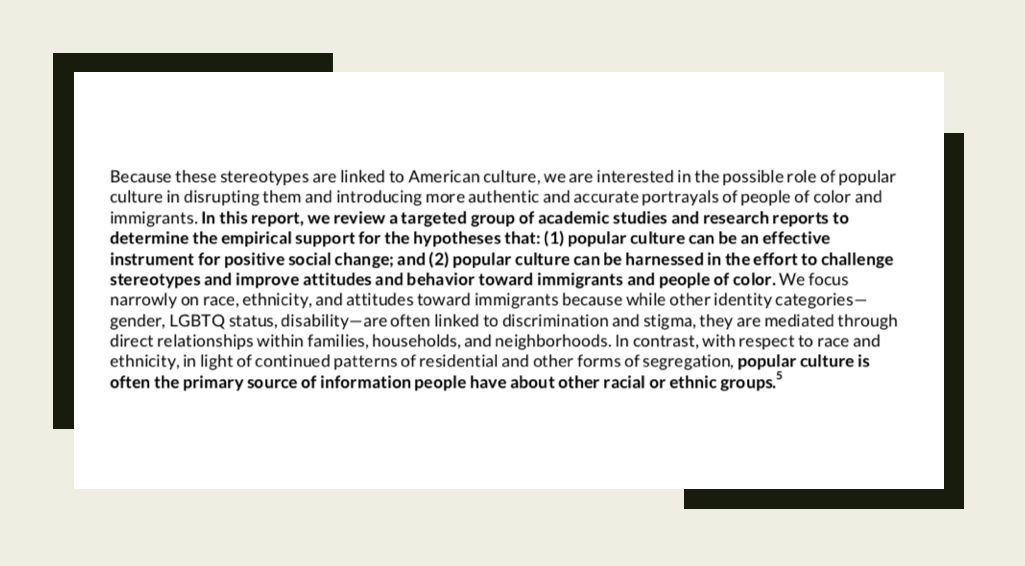How to Write A Research Proposal - Tips from #PopJustice
It’s hard to say what the most difficult part of developing a research project is - the research question, the research process, the literature review, getting started, finishing… the list is endless. That’s why is an important skill to develop, and it’s why I incorporate a research project proposal in the my second-year undergraduate class. (Another reason is that popular culture is so much fun to research and the possible topics are infinite!)
In order to help my students through the process of creating a research project proposal (note that it’s just a proposal, not a completed study), I like to do two things: (1) provide tons of examples of possible topics that they can look at, and (2) provide an example of a really good research project that they can look to for inspiration and guidance. That’s where this report published by the Perception Institute comes in. It has all of the key components of a really good research study - the introduction and literature review are particularly outstanding, a calibre of synthesis, analysis and clear writing that I aspire to.
For the purpose of my course, the final assignment and exam (the research project proposal) should have the following sections:
An Introduction
A Literature Review
A Research Problem, Research Question(s), or Hypothesis
A (Proposed) Methodology
A Conclusion
A Reference List
Let’s look at these sections in more detail together.
The Introduction
A good introduction provides an overview of the research that has been (or will be, in the context of a research proposal) undertaken. It’ll explain why it’s important and what the researchers have set out to ‘prove’ or ‘disprove’ - or explain, examine, investigate…
The #PopJustice article does a stellar job clearly demonstrating (1) why they’re interested in their topic, (2) how they plan to investigate it, (3) what their hypotheses are, and (4) why it’s important to research and read about. Let’s take a look and see how they did it.
This paragraph comes right from their Introduction. Can you identify why they decided to do this research?
Great! Now, how did they carry out their research project? What was methodological design did they use?
Ok. We’re making progress. Next, what were they trying to prove? In other words, what was their hypothesis? (Hint: There were two.)
Finally, what was the justification the authors provided for undertaking this research? Why does it matter? Why is it important?
Just think! We got all that from one paragraph!
The Literature Review
The Literature Review section provides the reader (and the researchers) with foundational knowledge on the topic at hand. It synthesizes prior areas of research to prevent duplication and give credit to other researchers while carving out a place for your own research by identifying inconsistencies, gaps, conflicts, and areas for further study in existing research. By doing this, the literature review leads to the research question(s) or hypothesis.
This is also where we find the definition of key concepts and variables as well as an explanation of any theoretical framework that the research is relying on.
As we saw in the Introduction, the #PopJustice article tested two hypotheses:
(1) Popular culture can be an effective instrument for positive social change
(2) Popular culture can be harnessed in the effort to challenge stereotypes and improve attitudes and behavior towards immigrants and people of color.
Let’s see how they defined their variables.
Their first variable is “popular culture”. How did they define this?
The authors went beyond this definition and explained what they meant by ‘popular culture’ using examples.
Their second variable was “social change”.
How did they define this?
Now that we have a clear understanding of what we’re measuring and assessing, the report continued on to identify gaps in the literature. (You can check out a recap of Class 6, which covered the substantive content found in the report here. This post focuses on the format and sections of a research project proposal and doesn’t get into that too much.)
Once the gaps are identified and we figure out what’s missing or what still needs to be examined, tested, etc, in this field of study, we can establish our research question(s) or hypothesis.
The Research Question(s) or Hypothesis
Normally, the research question(s) or hypothesis are derived from the Literature Review. What that means is that once you’ve identified a gap in the literature - a “space” for your research to fit in - then you develop a research question or hypothesis that addresses this gap.
Methodology
The methodology section of a research proposal explains what the researchers plan on doing to answer their research question(s) or test their hypothesis. It should also identify any expected limitations of the research project.
Conclusion
Finally, the conclusion of a research proposal should include an overview of the expected findings of a study and should reiterate why the study is important and worth doing. It should explain how it will contribute to the existing scholarly research and should connect it with larger ‘real-world’ implications.












